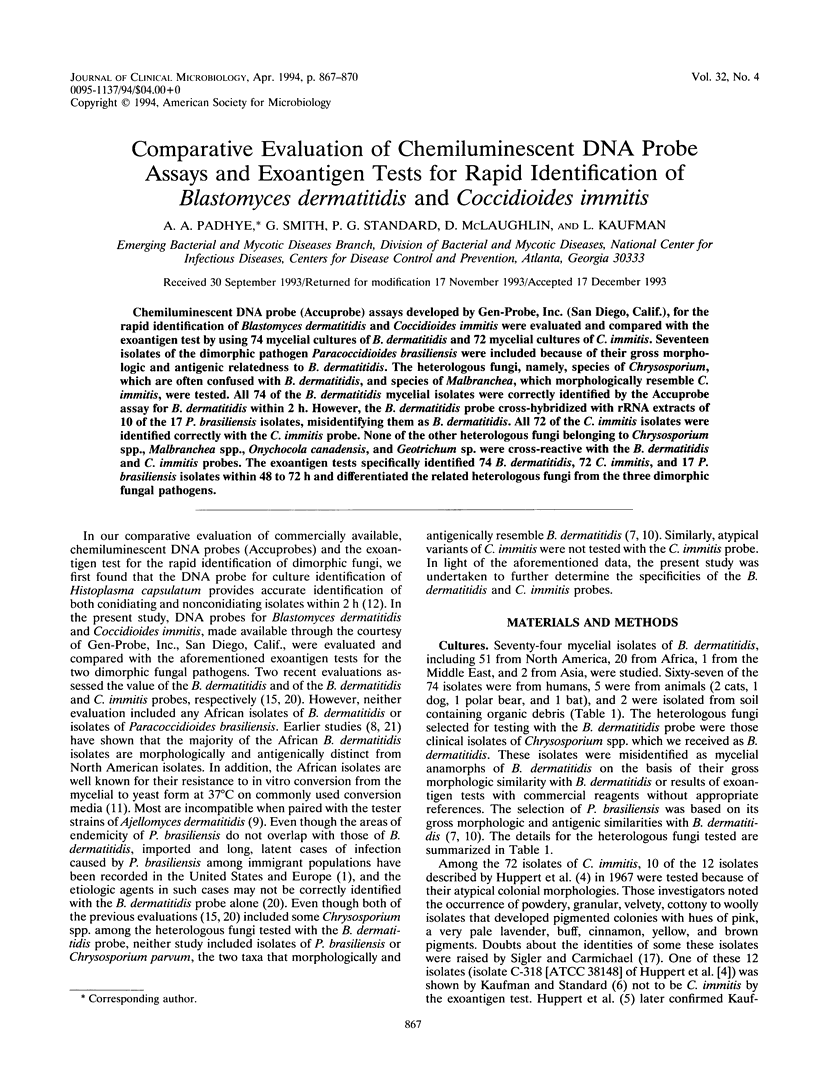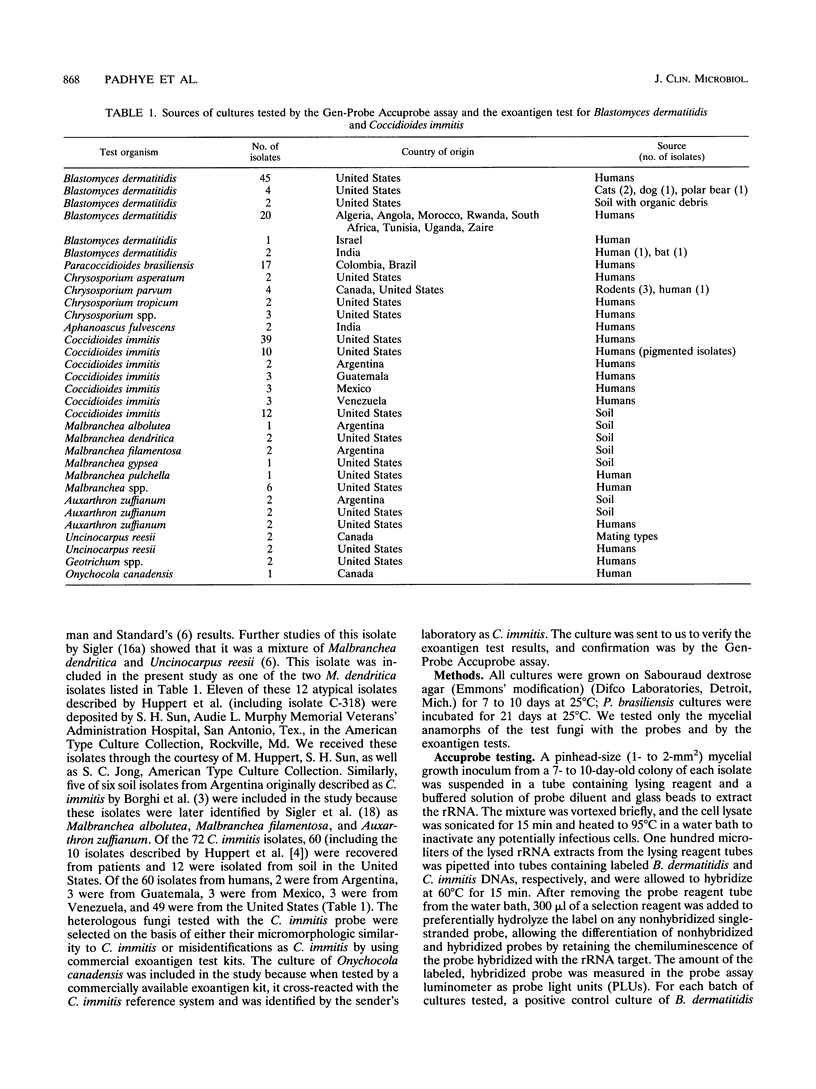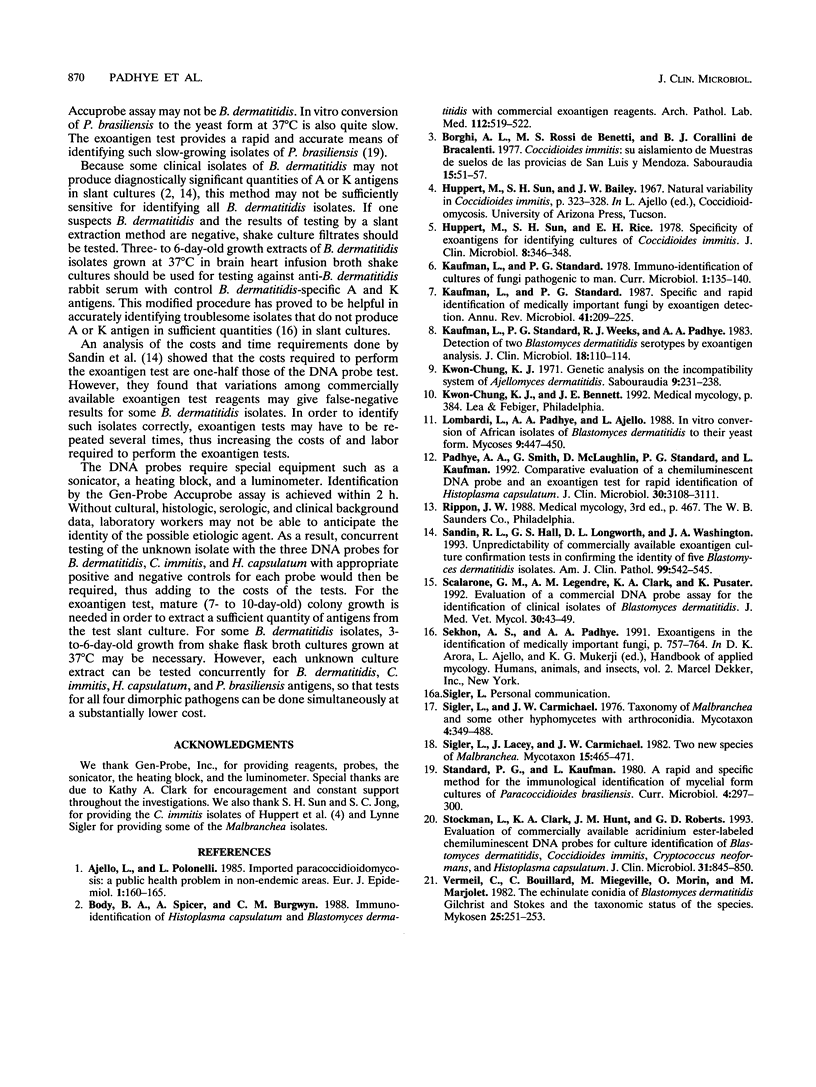Abstract
Chemiluminescent DNA probe (Accuprobe) assays developed by Gen-Probe, Inc. (San Diego, Calif.), for the rapid identification of Blastomyces dermatitidis and Coccidioides immitis were evaluated and compared with the exoantigen test by using 74 mycelial cultures of B. dermatitidis and 72 mycelial cultures of C. immitis. Seventeen isolates of the dimorphic pathogen Paracoccidioides brasiliensis were included because of their gross morphologic and antigenic relatedness to B. dermatitidis. The heterologous fungi, namely, species of Chrysosporium, which are often confused with B. dermatitidis, and species of Malbranchea, which morphologically resemble C. immitis, were tested. All 74 of the B. dermatitidis mycelial isolates were correctly identified by the Accuprobe assay for B. dermatitidis within 2 h. However, the B. dermatitidis probe cross-hybridized with rRNA extracts of 10 of the 17 P. brasiliensis isolates, misidentifying them as B. dermatitidis. All 72 of the C. immitis isolates were identified correctly with the C. immitis probe. None of the other heterologous fungi belonging to Chrysosporium spp., Malbranchea spp., Onychocola canadensis, and Geotrichum sp. were cross-reactive with the B. dermatitidis and C. immitis probes. The exoantigen tests specifically identified 74 B. dermatitidis, 72 C. immitis, and 17 P. brasiliensis isolates within 48 to 72 h and differentiated the related heterologous fungi from the three dimorphic fungal pathogens.
Full text
PDF



Selected References
These references are in PubMed. This may not be the complete list of references from this article.
- Ajello L., Polonelli L. Imported paracoccidioidomycosis: a public health problem in non-endemic areas. Eur J Epidemiol. 1985 Sep;1(3):160–165. doi: 10.1007/BF00234089. [DOI] [PubMed] [Google Scholar]
- Body B. A., Spicer A., Burgwyn C. M. Immunoidentification of Histoplasma capsulatum and Blastomyces dermatitidis with commercial exoantigen reagents. Effect of culture age. Arch Pathol Lab Med. 1988 May;112(5):519–522. [PubMed] [Google Scholar]
- Borghi A. L., Rossi de Benetti M. S., Corallini de Bracalenti B. J. Coccidioides immitis: su aislamiento de muestras de suelos de las provincias de San Luis y Mendoza. Sabouraudia. 1977 Mar;15(1):51–57. [PubMed] [Google Scholar]
- Huppert M., Sun S. H., Rice E. H. Specificity of exoantigens for identifying cultures of Coccidioides immitis. J Clin Microbiol. 1978 Sep;8(3):346–348. doi: 10.1128/jcm.8.3.346-348.1978. [DOI] [PMC free article] [PubMed] [Google Scholar]
- Kaufman L., Standard P. G. Specific and rapid identification of medically important fungi by exoantigen detection. Annu Rev Microbiol. 1987;41:209–225. doi: 10.1146/annurev.mi.41.100187.001233. [DOI] [PubMed] [Google Scholar]
- Kaufman L., Standard P. G., Weeks R. J., Padhye A. A. Detection of two Blastomyces dermatitidis serotypes by exoantigen analysis. J Clin Microbiol. 1983 Jul;18(1):110–114. doi: 10.1128/jcm.18.1.110-114.1983. [DOI] [PMC free article] [PubMed] [Google Scholar]
- Kwon-Chung K. J. Genetic analysis on the incompatibility system of Ajellomyces dermatitidis. Sabouraudia. 1971 Nov;9(3):231–238. [PubMed] [Google Scholar]
- Lombardi G., Padhye A. A., Ajello L. In vitro conversion of African isolates of Blastomyces dermatitidis to their yeast form. Mycoses. 1988 Sep;31(9):447–450. [PubMed] [Google Scholar]
- Padhye A. A., Smith G., McLaughlin D., Standard P. G., Kaufman L. Comparative evaluation of a chemiluminescent DNA probe and an exoantigen test for rapid identification of Histoplasma capsulatum. J Clin Microbiol. 1992 Dec;30(12):3108–3111. doi: 10.1128/jcm.30.12.3108-3111.1992. [DOI] [PMC free article] [PubMed] [Google Scholar]
- Sandin R. L., Hall G. S., Longworth D. L., Washington J. A. Unpredictability of commercially available exoantigen culture confirmation tests in confirming the identity of five Blastomyces dermatitidis isolates. Am J Clin Pathol. 1993 May;99(5):542–545. doi: 10.1093/ajcp/99.5.542. [DOI] [PubMed] [Google Scholar]
- Scalarone G. M., Legendre A. M., Clark K. A., Pusater K. Evaluation of a commercial DNA probe assay for the identification of clinical isolates of Blastomyces dermatitidis from dogs. J Med Vet Mycol. 1992;30(1):43–49. doi: 10.1080/02681219280000061. [DOI] [PubMed] [Google Scholar]
- Stockman L., Clark K. A., Hunt J. M., Roberts G. D. Evaluation of commercially available acridinium ester-labeled chemiluminescent DNA probes for culture identification of Blastomyces dermatitidis, Coccidioides immitis, Cryptococcus neoformans, and Histoplasma capsulatum. J Clin Microbiol. 1993 Apr;31(4):845–850. doi: 10.1128/jcm.31.4.845-850.1993. [DOI] [PMC free article] [PubMed] [Google Scholar]
- Vermeil C., Bouillard C., Miegeville M., Morin O., Marjolet M. The echinulate conidia of Blastomyces dermatitidis Gilchrist and Stokes and the taxonomic status of this species. Mykosen. 1982 May;25(5):251–253. doi: 10.1111/j.1439-0507.1982.tb02750.x. [DOI] [PubMed] [Google Scholar]


